
Click on any photo for a larger image.
Plants are listed A-Z by family, then A-Z by species. Common names in English and Spanish are noted if available.
Families: A-B | C-E | F-M | N-Z


Click on any photo for a larger image.
Plants are listed A-Z by family, then A-Z by species. Common names in English and Spanish are noted if available.
Families: A-B | C-E | F-M | N-Z
There are a number of these shrubs around the property. Photos below were taken right at the corner of the patio and walkway (#3 on the map) as well as in the northwest area, between #6 & #7 on the map (the ones with fruit).
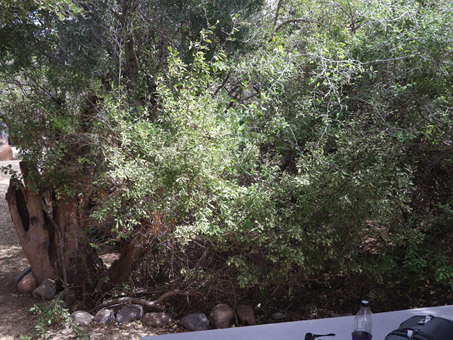
Phaulothamnus spinescens, Snake eyes, Casa de Cochi, Putia, Bashata. Woody, spiny shrub.
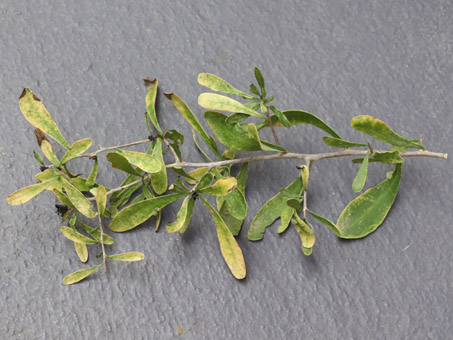
Phaulothamnus spinescens.

Phaulothamnus spinescens.
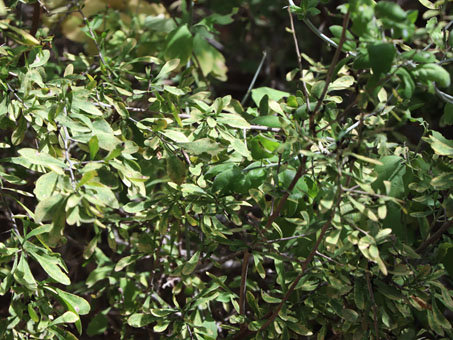
Phaulothamnus spinescens, Snake eyes, Casa de Cochi, Putia, Bashata. Woody, spiny shrub.
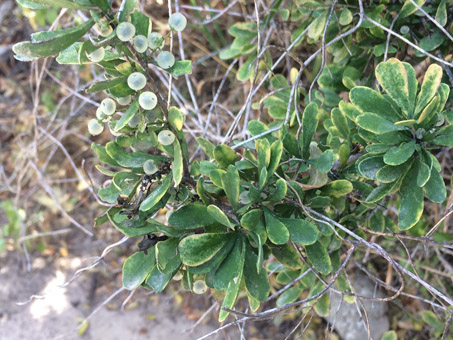
Phaulothamnus spinescens.
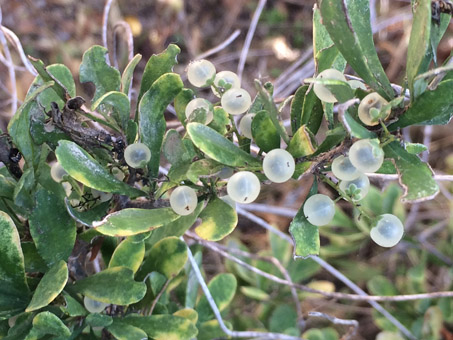
Phaulothamnus spinescens.
Agavaceae (Agave Family)
Anacardiaceae (Sumac Family)
Cyrtocarpa edulis. Wild plum, Ciruelo cimarron.
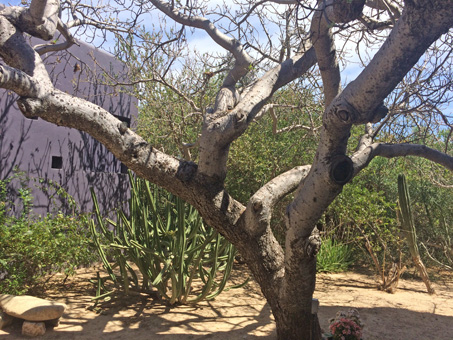
Cyrtocarpa edulis. Wild plum, Ciruelo cimarron.
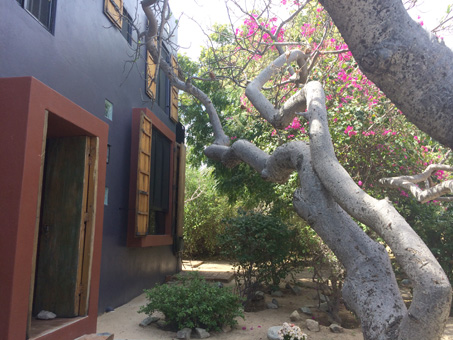
Cyrtocarpa edulis. Wild plum, Ciruelo cimarron.
Cyrtocarpa edulis. Wild plum, Ciruelo cimarron.
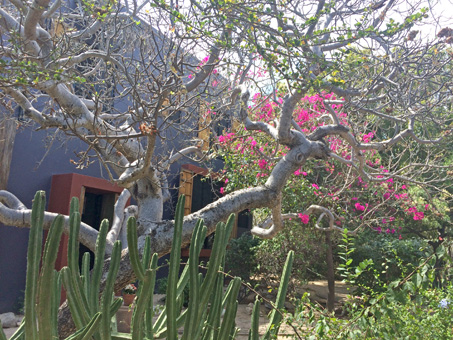
Cyrtocarpa edulis. Wild plum, Ciruelo cimarron.
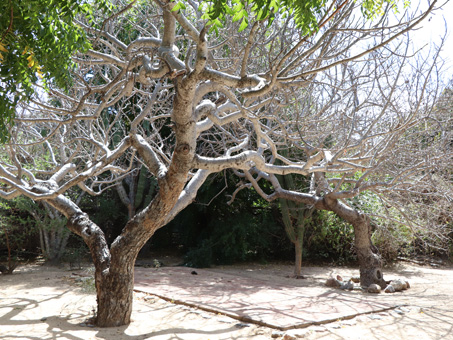
Cyrtocarpa edulis. Wild plum, Ciruelo cimarron.
Apocynaceae (Dogbane, Milkweed Family)
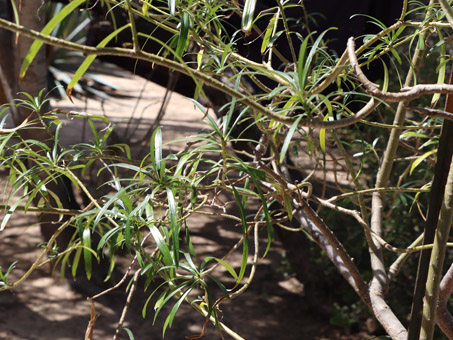
Thevetia peruviana. Also known as Cascabela thevetia. Lucky Nut, Still tree. This is a poisonous plant, related to Oleander and milkweeds.
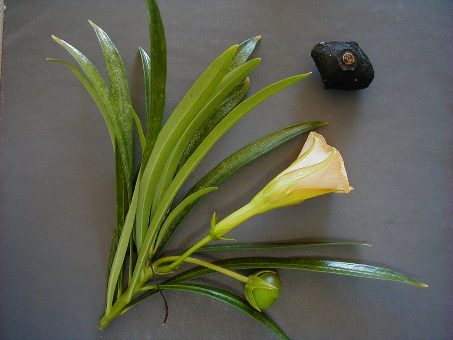
Thevetia peruviana. Also known as Cascabela thevetia. Lucky Nut, Still tree. This is a poisonous plant, related to Oleander and milkweeds.
Asteraceae (Sunflower Family)
A large cluster of this species was seen between #6 & #7 on map, mixed in with Phaulothamnus spinescens. There was an opening on the southern side of the area as one walks back deep into the scrub to the west (location #7).
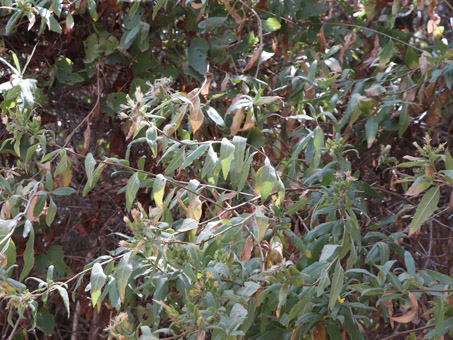
Trixis californica var. peninsularis. Peninsular Threefold; Santa Lucía.
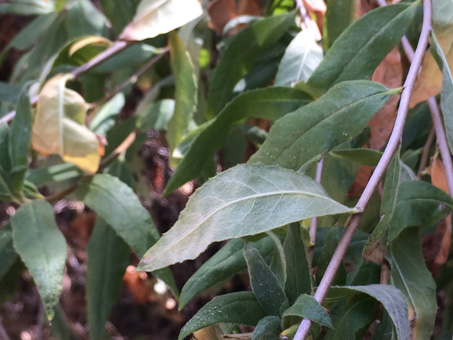
Trixis californica var. peninsularis
Burseraceae (Torchwood Family)
Cactaceae (Cactus Family)
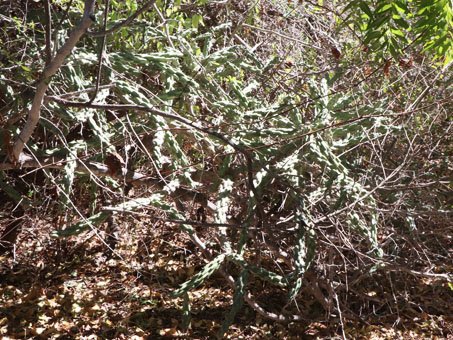
Cylindropuntia cholla. Chain-link cholla, Cholla pelona.
Cardón barbón (L) and Lophocereus schottii (R).
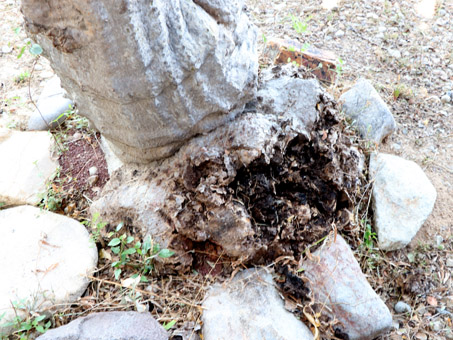
Infected (?) Cardón barbón
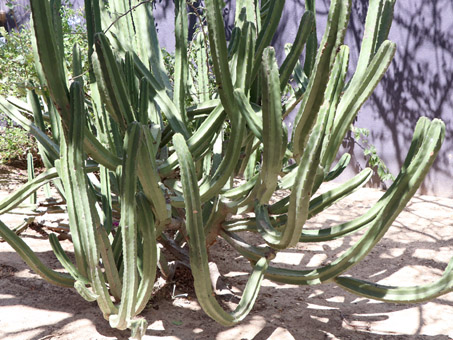
Lophocereus schottii var. australis. Old-man Cactus, Garambullo.
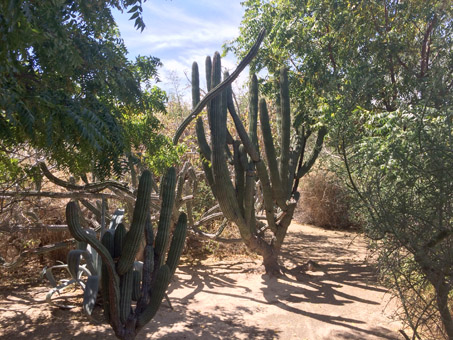
Lophocereus schottii. Organpipe cactus, Pitahaya dulce.
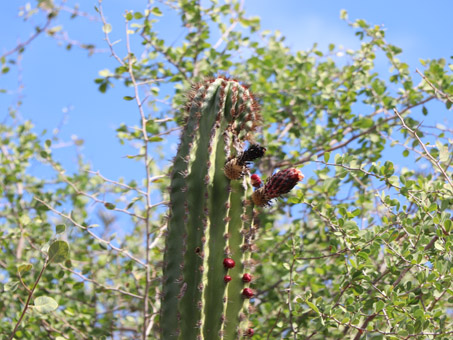
Pachycereus pecten-aboriginum (Cardón barbón) with Condalia brandegeei behind.
Cardón barbón with Palo Brasil tree (upper R).
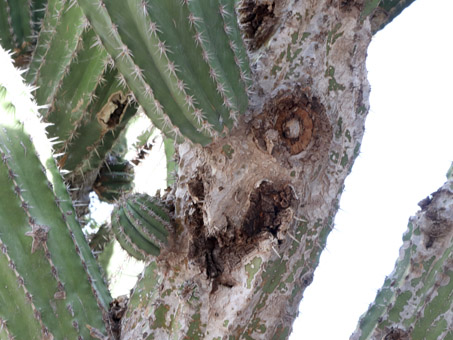
Infected (?) Cardón barbón
Lophocereus schottii var. australis

Stenocereus thurberi. Location #7.
Cannabaceae (Hemp Family)
Celtis pallida is a shrub to 5 m tall. Branches have a zig-zag pattern. Leaves have three main veins that arise from near the base of the leaf. The leaf margins (edges) at the base are asymmetrical (see the first photo below on the left to see the offset in the leaf base. Thorns are somewhat short and either solitary or paired at the leaf axils. The flower is green-yellow and inconspicuous. At maturity, the small fruit (8-10 mm W) is orange. I'm not exactly sure where I took these photos, but I believe it was somewhere between locations #3 & 12 on the east side of the walkway between the driveway and the front patio, perhaps closer to #13, where the Dot-and-Dash bush is located.
Euphorbiaceae (Spurge or Euphorbia Family)
Fabaceae (Pea Family)
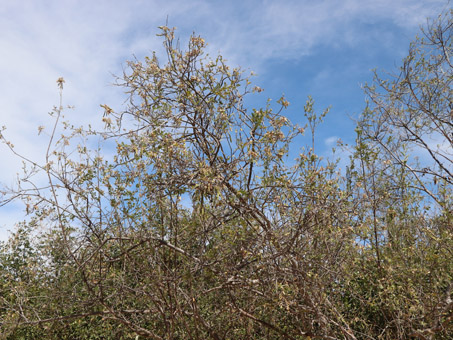
Coursetia glandulosa. Rosary Babybonnets (what a name!)
Coursetia glandulosa. Pinnate leaves.
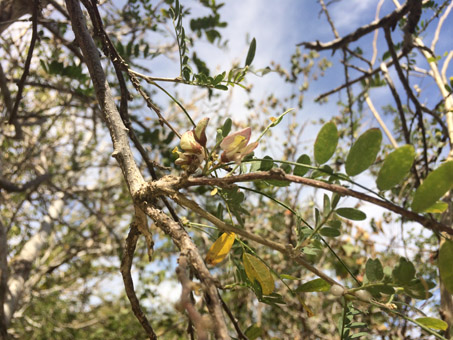
Coursetia glandulosa
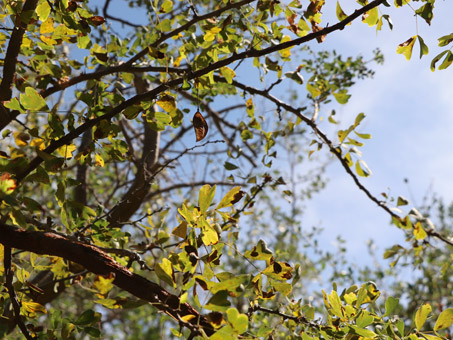
Haemotoxylon brasiletto. Brazil wood, Mexican logwood, Palo Brasil. Classified as a tropical hardwood.
Location #12 on map.
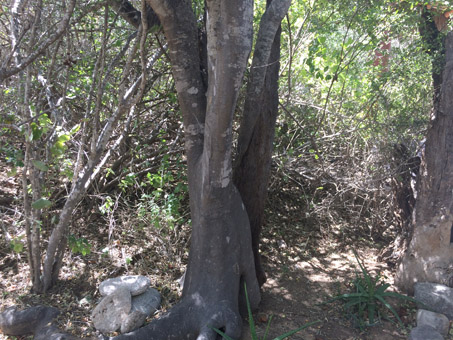
Haemotoxylon brasiletto. Near #6 on map?.
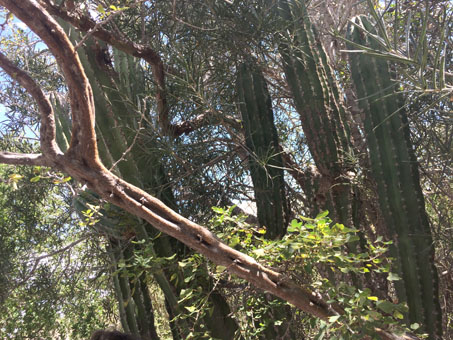
Haemotoxylon brasiletto. Location #12 on map.
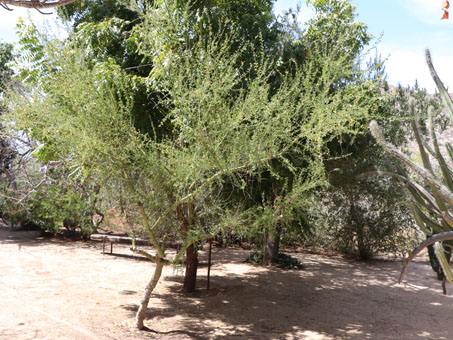
Parkinsonia florida. Blue Palo Verde, Peninsular Palo Verde; Palo Verde, Palo de Pua.
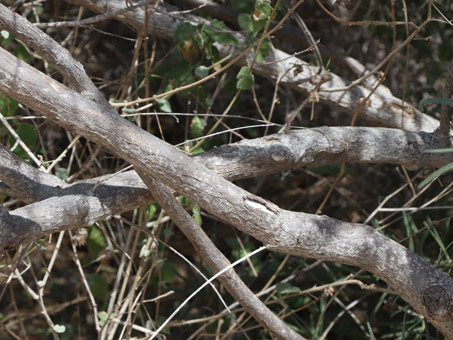
Coursetia glandulosa (all from around #11 on map)
Coursetia glandulosa. White, yellow and reddish flowers with a glandular legume.

Coursetia glandulosa
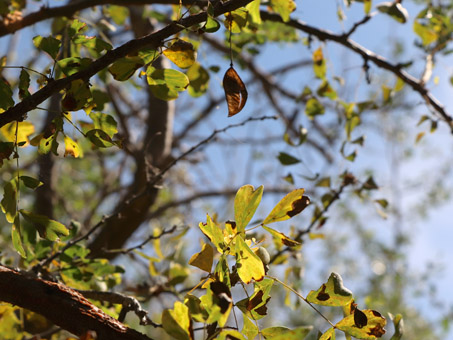
Haemotoxylon brasiletto. Note the heart-shaped leaves and the flat, odd-shaped light brown legume (upper middle). Location #12 on map.
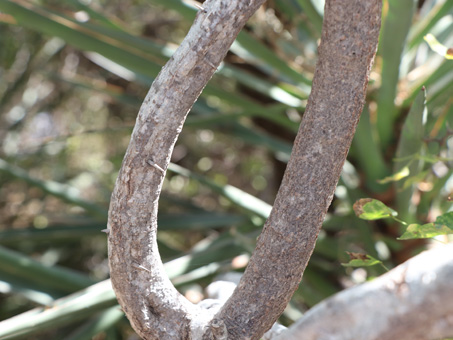
Haemotoxylon brasiletto. Location #12 on map.
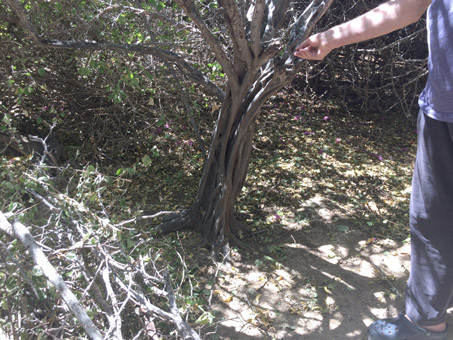
Haemotoxylon brasiletto. Between #6 & #7 on map?
Malvaceae (Mallow Family)
Meliaceae (Chinaberry Family)
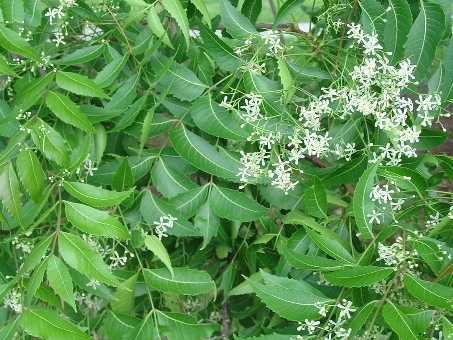
Azadirachta indica. Photo credit: HoneyArchives.
Polygonaceae (Buckwheat Family)
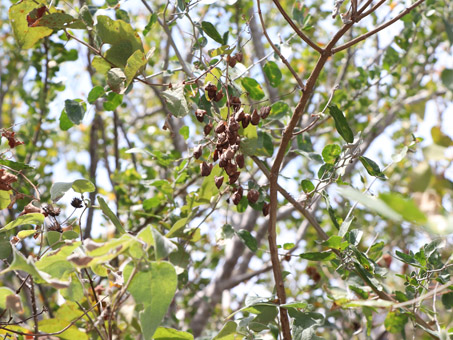
Antigonon leptopus. Coralvine, San Miguelito. The fruit is hard like a nut and has a loose brown, papery cover. Visible in photo. Flowers are dark pink.
Located between #2 & #3 on the map, north edge of the path.
Resedaceae (Reseda Family)
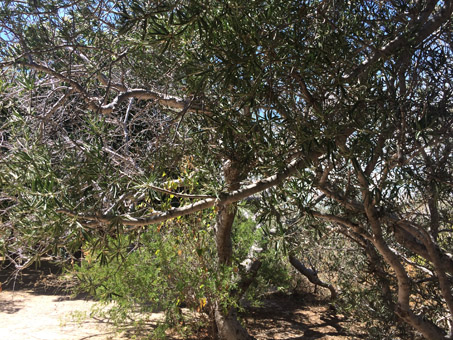
Forchhammeria watsonii. Palo San Juan, Jito.
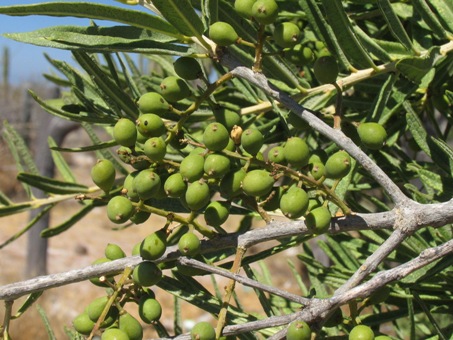
Forchhammeria watsonii. Fruit from pistillate (female) tree. The fruit is a drupe, similar to what an olive is. Pistillate and staminate trees are separate, though occasionally a fruit may be found here and there within a cluster of staminate flowers. (photo from elsewhere).
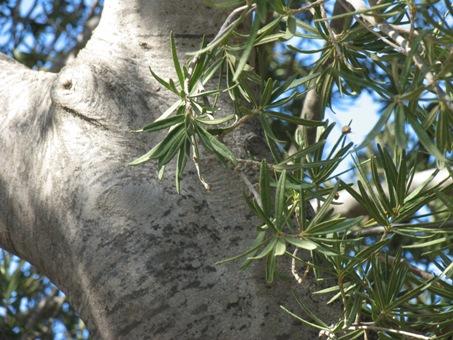
Forchhammeria watsonii. Leaves are long, narrow and leathery. I don't think there are any other species of trees with these types of leaves in the region.
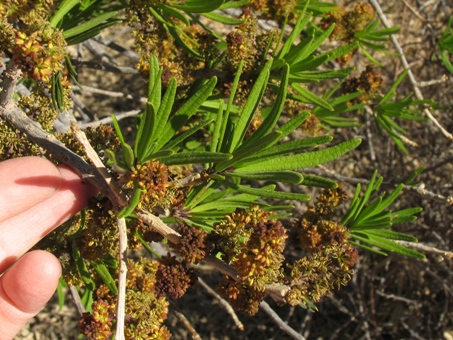
Forchhammeria watsonii. Staminate (male flowers, each flower is basically just a mass of stamens. Your tree by the north side is like this, a male, usually covered in bees and other nectiferous insects (photo from elsewhere).
Rhamnaceae (Buckthorn Family)
The bark on Colubrina viridis shrub is variable. It can peel off in thick pieces (see photos below). Underneath it is commonly reddish, but can also be greenish below a reddish-brown bark. The fruit is a drupe, looks like a very small dry cherry. Flowers are small and inconspicuous, very similar to (but smaller than) those of the Dot-and-Dash bush seen below.
Colubrina viridis. Snakewood, Palo Colorado.
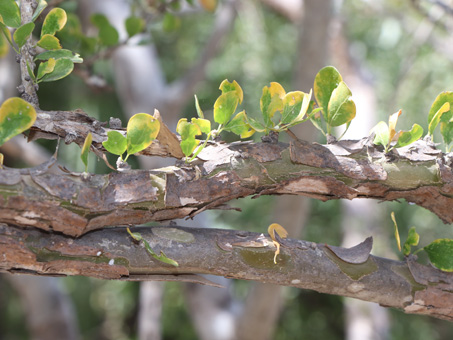
Colubrina viridis. These from between #2 & #3 on the map.
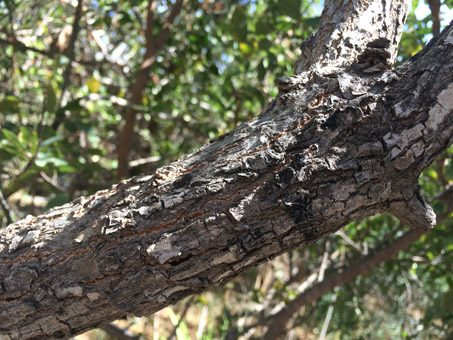
Karwinskia humboldtiana. Dot-and-Dash Bush, Cacachilla. This shrub is located between the two large buildings, along the east side path. It is a shrub or small tree like here.
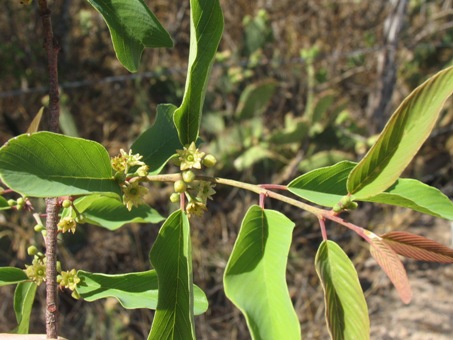
Karwinskia humboldtiana. Flowers are just under 1 cm D and star-like.
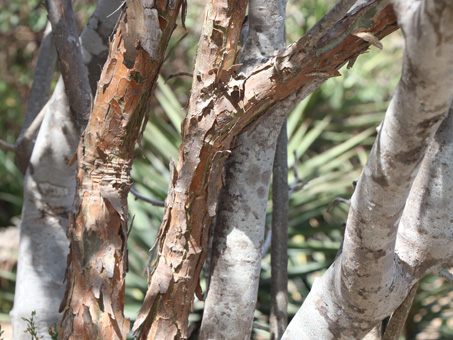
Colubrina viridis (reddish) with Jatropha or ciruelo branches
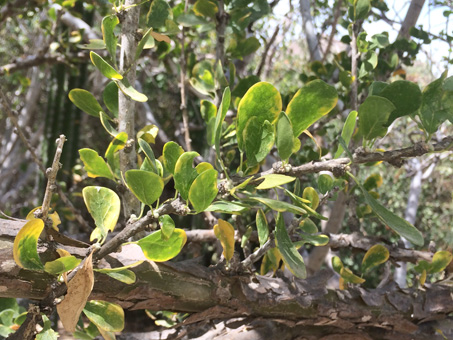
Colubrina viridis
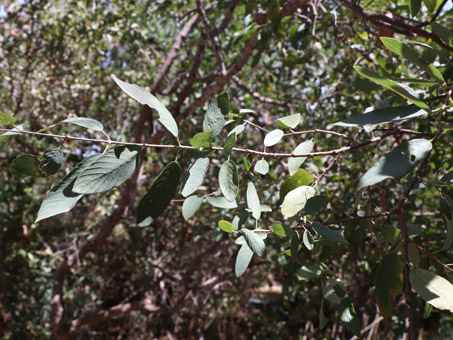
Karwinskia humboldtiana. Dot-and-Dash Bush, Cacachilla. The leaves can be gray-green like here, or brighter green as below. They are arranged oppositely.
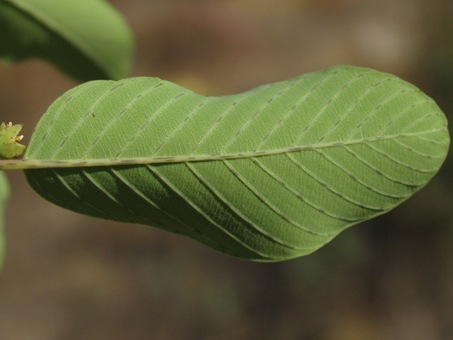
Karwinskia humboldtiana. The reason for the english common name is clear if you click to enlarge this photo. The black dots and dashes are visible along the veins. Dot-and-Dash Bush, Cacachilla.
Simaroubaceae
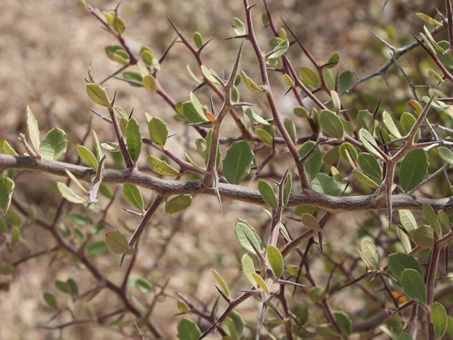
Castela peninsularis, Palo Amargoso. Leaves are small, thickened, about 1-2.5 cm L; margins with a few teeth and often slightly rolled under just at edge. Branches are sharply spinose. Note a bit of zig-zagging of the branches.
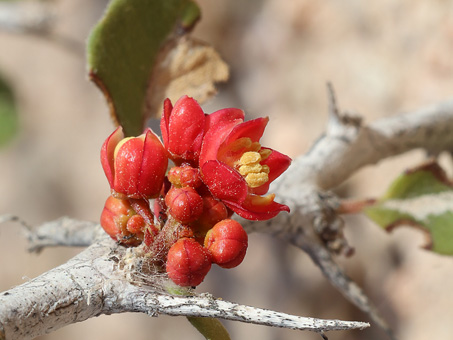
Castela peninsularis. Flowers and flower buds.

Castela peninsularis. Flowers are about 7-8 mm L, with 4 petals.

Castela peninsularis. Fruit are like very small cherries and EXTREMELY bitter. Believe me!
Unknown Plants (Still)
#1 Species unknown. The tree is located at the end of the front walk on the right just before arriving at the main house/patio (location #3 on map) and the walk that goes right towards the other building and back area.
#1 Species unknown. The leaves appear to be joined near the base though they are not actually attached. The tips are pointy.

#2 - Species unknown (location). The unknown plant has the larger leaves up in the wild plum tree. The bright green shrub below is Ejotón. Location #8.
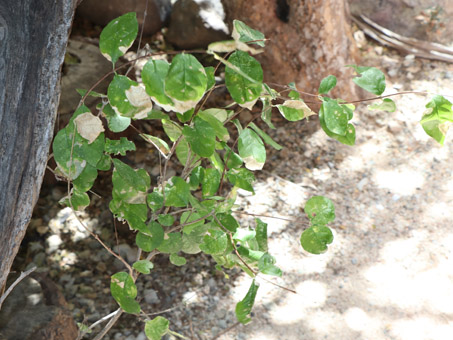
#3 - Species unknown. At the base of Unknown #1 (location #3).
#1 Species unknown
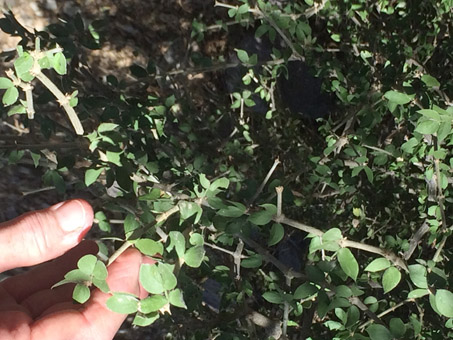
#1 Species unknown. There appear to be very short, stubby spines at some leaf axils. No flowers or fruit were observed.
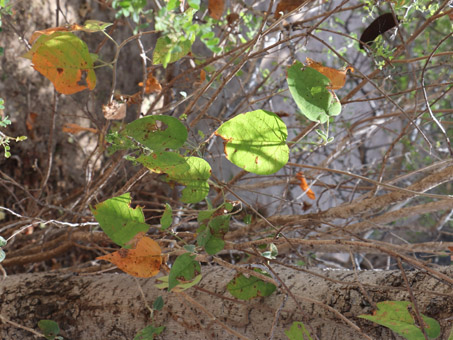
#2 - Species unknown
Garden Views
From Google Earth. Numbers correspond to location numbers in text. Hopefully they are fairly accurate, as the GPS on the camera was often way off due to a poor signal from beneath the trees/shrubs.
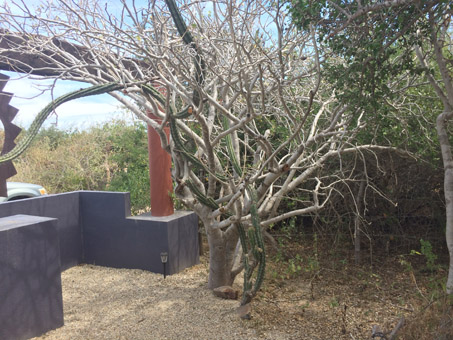
Garden view #1: Front gate.

Garden view #3: towards front gate. Forchammeria watsonii on the far right, unknown #1 on far left.
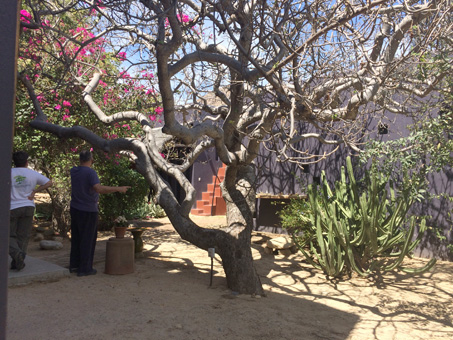
Garden view #5: Your beautiful wild plum/Ciruelo cimarrón (Cyrtocarpa edulis). The fruit is edible. As you can see, the tree is deciduous.
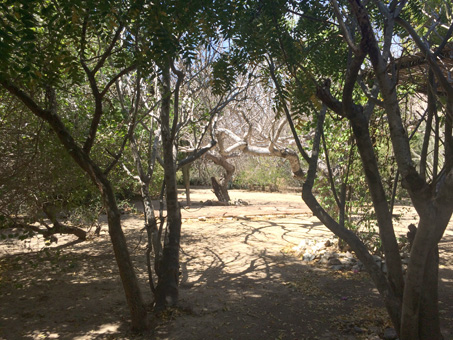
Garden view #6: from what I can tell, these are Neem trees arching over on left and right.
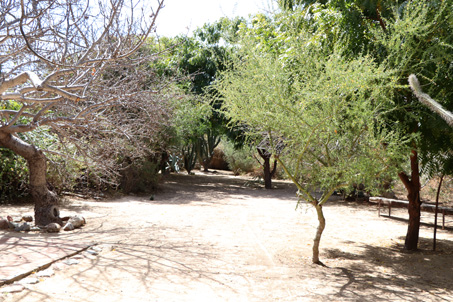
Garden view #6 (nearby): looking towards the west past the buildings and driveway.
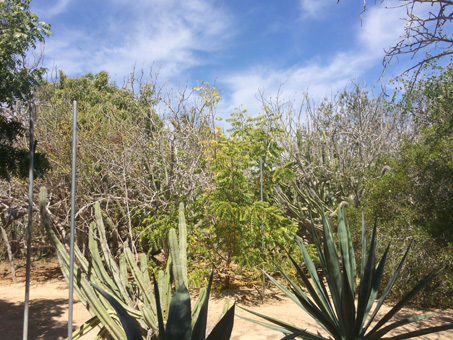
Garden view: Neems, Old-man cactus, Maguey (Agave)...Between #8 & #9 on map, I think.
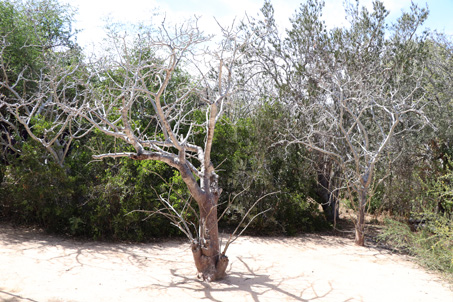
Garden view #10: I think these are Ashy Limberbush (Jatropha cinerea or J. vernicosa). If so, when they have leaves, they will be large and heart-shaped. The bark is basically smooth and the branches very flexible.
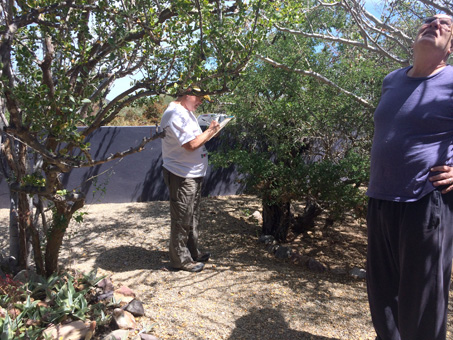
Garden view #2: Near front.
Garden view #3: from front path towards house. Unknown #1 on right at corner of paths.
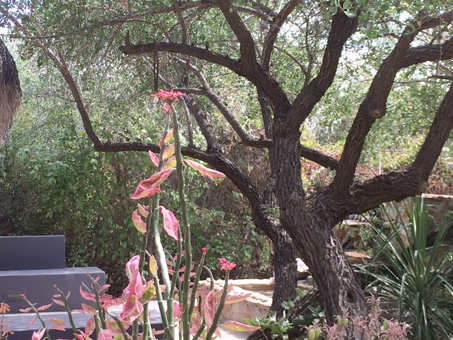
Garden view #5: From the bark, the big tree looks like another Condalia brandegeei tree.
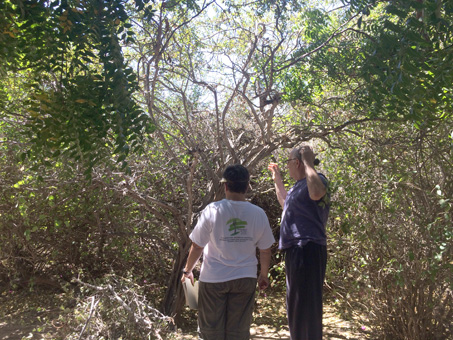
Garden view #6. I think this is another Palo Brasil
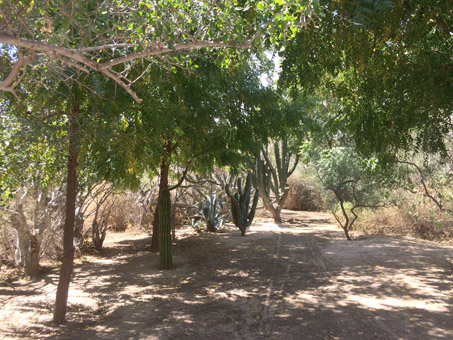
Garden view #7: same as on right, farther back.
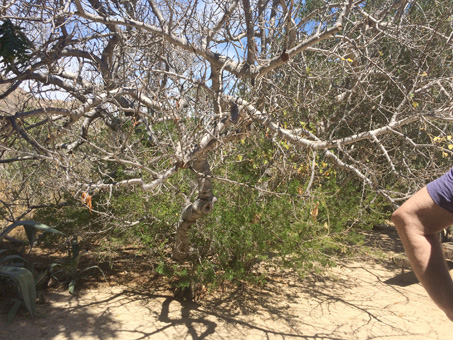
Garden view #8: Back beyond drive way. I think this is another Wild plum from what I can see. The shrub underneath is Ejotón (Ebenopsis confine) which has large dark woody pods, giving it the common English name Dog-poop Bush. It is very spiny with tiny leaves. Pea family.